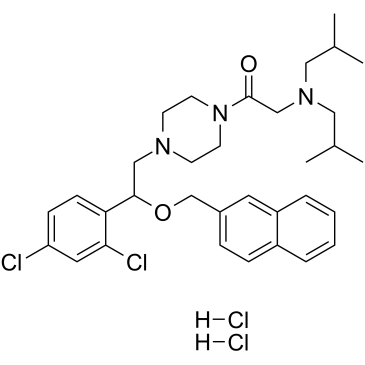LYN-1604 dihydrochloride
Modify Date: 2024-01-07 18:30:13

LYN-1604 dihydrochloride structure
|
Common Name | LYN-1604 dihydrochloride | ||
|---|---|---|---|---|
| CAS Number | 2310109-38-5 | Molecular Weight | 657.54 | |
| Density | N/A | Boiling Point | N/A | |
| Molecular Formula | C33H45Cl4N3O2 | Melting Point | N/A | |
| MSDS | N/A | Flash Point | N/A | |
Use of LYN-1604 dihydrochlorideLYN-1604 dihydrochloride is a potent UNC-51-like kinase 1 (ULK1) activator (EC50=18.94 nM) for the research of triple negative breast cancer (TNBC)[1]. |
| Name | LYN-1604 dihydrochloride |
|---|
| Description | LYN-1604 dihydrochloride is a potent UNC-51-like kinase 1 (ULK1) activator (EC50=18.94 nM) for the research of triple negative breast cancer (TNBC)[1]. |
|---|---|
| Related Catalog | |
| Target |
ULK1:18.94 nM (EC50) |
| In Vitro | LYN-1604 is a potential ULK1 agonist (enzymatic activity=195.7% at 100 nM and IC50=1.66 μM against MDA-MB-231 cells) [1]. LYN-1604 binds to wild-type ULK1 with a binding affinity in the nanomole range (KD=291.4 nM) [1]. LYN-1604 (0.5, 1.0 and 2.0 μM) induces cell death via the ULK complex in MDA-MB-231 cells[1]. LYN-1604 (0.5-2 μM, 24 hours) induces remarkable up-regulation of Beclin-1 and degradation of p62, as well as transformation of LC3-I to LC3-II in MDA-MB-231 cells[1]. LYN-1604 induces ATG5-dependent autophagy via the ULK complex[1]. LYN-1604 can also increase cleavage of caspase3 and induce apoptosis[1]. Cell Viability Assay[1] Cell Line: MDA-MB-231 cells Concentration: 0.5, 1.0 and 2.0 μM Incubation Time: Result: Induced cell death. Autophagy ratio was increased in a dose-dependent manner. Western Blot Analysis[1] Cell Line: MDA-MB-231 cells Concentration: 0, 0.5, 1, and 2 μM Incubation Time: 24 hours Result: Induced remarkable up-regulation of Beclin-1 and degradation of p62, as well as transformation of LC3-I to LC3-II. |
| In Vivo | LYN-1604 (low dose, 25 mg/kg; median dose, 50 mg/kg; high dose, 100 mg/kg; intragastric administration once a day for 14 days) inhibits the growth of xenograft TNBC by targeting ULK1-modulated cell death[1]. Animal Model: 24 female nude mice (BALB/c, 6-8 weeks, 20-22 g)[1] Dosage: Low dose, 25 mg/kg; median dose, 50 mg/kg; high dose, 100 mg/kg Administration: Intragastric administration; once a day for 14 days Result: Significantly inhibited the growth of xenograft MDA-MB-231 cells. The body weights of mice were stable. By the end of the experiment, the liver and spleen weight indexes of mice were slightly increased in parts of the groups, while the kidney weight index was not affected in all dose groups. |
| References |
| Molecular Formula | C33H45Cl4N3O2 |
|---|---|
| Molecular Weight | 657.54 |